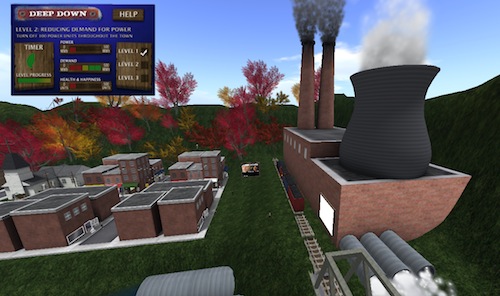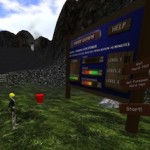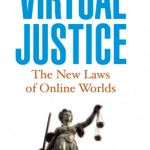 1. New Scientist (USA) – Online law man: Virtual worlds need real laws. “Tens of millions of people live, work and play in virtual worlds where anything goes. Greg Lastowka thinks we need to police these lawless frontiers. What prompted you to write your new book, Virtual Justice? I’ve always been interested in technology law, and the issues surrounding law in virtual worlds are like canaries in a coal mine. Society is increasingly migrating to the internet, and virtual worlds are an intense version of that. The issues that arise in virtual worlds will ultimately filter through to broader society.”
1. New Scientist (USA) – Online law man: Virtual worlds need real laws. “Tens of millions of people live, work and play in virtual worlds where anything goes. Greg Lastowka thinks we need to police these lawless frontiers. What prompted you to write your new book, Virtual Justice? I’ve always been interested in technology law, and the issues surrounding law in virtual worlds are like canaries in a coal mine. Society is increasingly migrating to the internet, and virtual worlds are an intense version of that. The issues that arise in virtual worlds will ultimately filter through to broader society.”
2. TechCrunch (USA) – Blue Mars Looks To OTOY’s Clouds To Take 3D Worlds Mainstream. “3D online virtual worlds are nothing new. From World of Warcraft to Second Life, people have been wandering across polygonal terrain for years, chatting with other users, selling their virtual wares, and making their avatars wave at each other for no apparent reason. But Avatar Reality, the startup behind a 3D platform called Blue Mars, thinks that there’s still a lot of untapped potential from 3D. And now it may have a way to turn their dream into something a lot of people are actually using.”
3. VentureBeat (USA) – Hip Venture abandons virtual world to pivot into social games (exclusive)
. “There’s a stampede going on. Publishers of virtual worlds are moving on to better things, or they’re perishing. Usually, that means they’re pivoting into the hot markets of social and mobile games. That explains the announcement today by virtual world maker Hip Venture that it will shift its focus to making social and mobile games. Previously, Hip Venture planned on creating a virtual world for tweens (older kids who are just shy of their teen years) with a Latino perspective. Now the company is repositioning its HipChicas.com virtual world so it can pursue the bigger market of social and mobile games. The New York-based company is adding new titles, new technology and key advisors to execute on its new strategy and will continue to focus on the US Hispanic, Latin American and Spanish markets. It plans to publish games on social networks such as Facebook, Orkut and Hi5 or mobile platforms such as the iPhone, iPad, and Droid. Its first game, HipChicas, will debut in the first quarter of 2011 and will be followed up with games based on popular Latino toy and book brands such as Homies, Mijoes, Hacienda, Bodeguita, and Hospital.”
4. Scope (USA) – Collaborative project creates a virtual world for cancer patients. “The pain and isolation of dealing with a cancer diagnosis are challenging emotional experiences for adults. Now imagine getting that diagnosis as an adolescent. But a new collaborative effort initiated by Mette Hoybye, PhD, a visiting scholar at the Center on Stress and Health, and Henrik Bennetsen, chief executive officer and co-founder of Katalabs, aims to fuse cancer therapy with virtual worlds to provide a learning space for young cancer patients. The project, which is aimed at patients ages 13 to 24, is called BE Community.”
5. Forbes (USA) – Meet The Man Who Just Made A Cool Half Million From The Sale Of Virtual Property. “Many people might balk at the idea of paying even a dollar for virtual cow in a game like Farmville. But Jon Jacobs has just sold a virtual space station he’s spent the past five years managing for a whopping $635,000 in total, making over half a million dollars. Who would devote so much time and investment into something that doesn’t exist in the real world?”
6. The Christian Post (USA) – Democratizing Evangelism in an eWorld. “Outreach in the electronic world is needed as people become increasingly dependent on technology to communicate, said Christian thinkers at a conference focused on the subject this week. While the good news should never change, methodologies used to communicate the message must change with the times, agreed attendees of the Great Commission Research Network’s annual conference, which concluded Thursday. The conference, titled “Outreach in an eWorld,” focused on how the average, local church can use the electronic medium to share the Good News. “The electronic medium is becoming a more powerful tool for good or for bad,” said Bob Whitesel, president of the Great Commission Research Network, to The Christian Post Thursday. “And the Church needs to know how to wield it for good and it needs to know how to take a stand against the bad.”
7. Hypergrid Business (Hong Kong) – The hypergrid’s not for everyone. “Ever since Crista Lopes, professor of informatics at the University of California, Irvine invented the hypergrid in 2009, people have been debating whether grids should be on or off the hypergrid. On the one hand, the hypergrid is very cool. You can teleport from one grid to another, hopping around like a grasshopper, picking up some freebies here, buying some clothes there, attending a meeting somewhere else, all with one avatar and a single inventory. On the other hand, hypergrid allows people to take content from one grid to another — and to harass people on other grids, as well. Some grids hedge their bets. They turn hypergrid on just during open houses, or during the construction phase. Or they only allow hypergrid to certain regions of their grid, and keep the rest private.”
8. The Quad News (USA) – Living in a Virtual Reality. “In 2007 seven individuals bought an island and embarked on a mission to create a place in which individuals could overcome religious differences and learn to live together—all in a virtual world.
The community, which is called, Al-Andalus was created using the online, 3D digital platform called Second Life. Second Life was founded and is now run by Linden Lab which is located in San Francisco, Calif. It is similar to other computer games, like the Sims, except for one large difference. In Second Life, every tree, every house, every shop, and every subway line is created by the people, or Avatars, playing the game–it is a virtual world created solely by the user.
One of the founders of A1-Andalus, just one of the dozens of communities that exist in Second Life, “Rose Springvale,” is a mother of two, an attorney and a wife to a CEO husband in the real world. ”
9. VentureBeat (USA) – Social entertainment world IMVU expands to Europe. “Social entertainment firm IMVU is launching a big expansion in Europe today as it unveils new versions in seven languages. With IMVU, users create their own 3D character, or avatar, and can then meet people, chat, create virtual goods and share them, and play games. The company is one of the few surviving virtual world startups that have grown a big audience and generated a lot of revenue. Keeping the growth going isn’t easy. But the European expansion should help. IMVU will now have localized versions in Dutch, French, German, Italian, Portuguese, Spanish and Swedish. The launch will start with a Swedish version, and the other six languages will roll out in the coming weeks. The company plans to continue its international expansion into 2011, said IMVU chief executive Cary Rosenzweig.”
10. Asharq Al-Awsat (UK) – The Virtual Hajj Experience. “It is now possible for every Muslim to learn how to perform the Hajj or Umrah rituals correctly through the online virtual world of “Second Life” before physically embarking on this spiritual journey in real life. It is now possible for people to learn how to perform the Hajj rituals by virtually visiting Mecca, Medina, and the other holy sites that must be visited as part of Hajj after the “Islam Online” website recently introduced an educational hajj program on the virtual world of “Second Life.” This project also aims to reduce the common errors made by many pilgrims. Hisham Jaafar, Editor-in -Chief of the “Islam Online” website told Asharq Al-Awsat that “Hajj Island” on Second Life includes a complete three dimensional representation of The Grand Mosque in Mecca following its recent development and enlargement. “Hajj Island” also allows users to travel between the Safah and Marawah hills, as well as visit Mina where “the stoning of the devil” ritual is performed. In order to simulate the rituals as realistically as possible, the model also includes the newly-built Royal Mecca Clock Tower, which overlooks the Grand Mosque, and is the largest clock-tower in the world. There will also be a virtual train linking Mina and Mount Arafat, with this train set to operate this year for the first time.”











Recent Comments